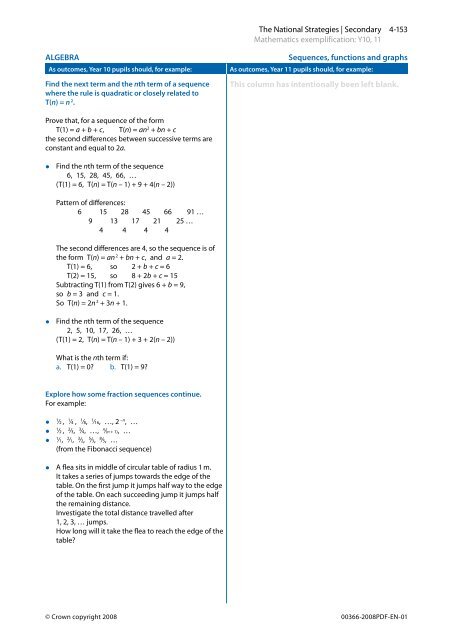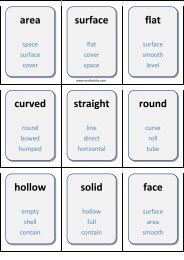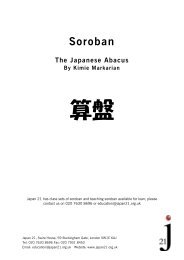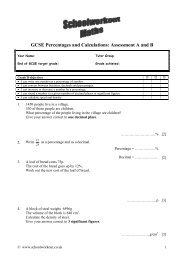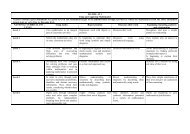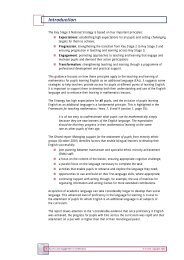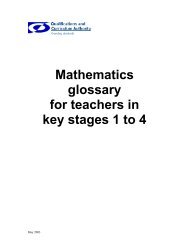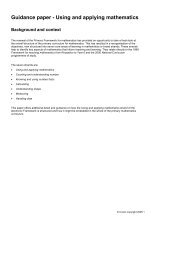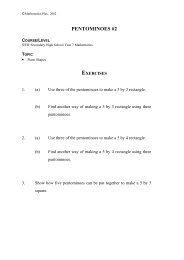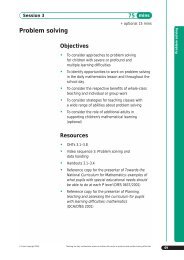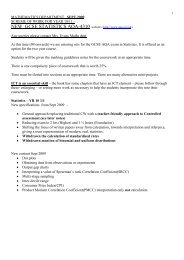ALGEBRA Equations, formulae, expressions and ... - Suffolk Maths
ALGEBRA Equations, formulae, expressions and ... - Suffolk Maths
ALGEBRA Equations, formulae, expressions and ... - Suffolk Maths
Create successful ePaper yourself
Turn your PDF publications into a flip-book with our unique Google optimized e-Paper software.
The National Strategies | Secondary<br />
Mathematics exemplification: Y10, 11<br />
4-153<br />
<strong>ALGEBRA</strong><br />
As outcomes, Year 10 pupils should, for example:<br />
Find the next term <strong>and</strong> the nth term of a sequence<br />
where the rule is quadratic or closely related to<br />
T(n) = n 2 .<br />
Sequences, functions <strong>and</strong> graphs<br />
As outcomes, Year 11 pupils should, for example:<br />
This column has intentionally been left blank.<br />
Prove that, for a sequence of the form<br />
T(1) = a + b + c, T(n) = an 2 + bn + c<br />
the second differences between successive terms are<br />
constant <strong>and</strong> equal to 2a.<br />
•<br />
Find the nth term of the sequence<br />
6, 15, 28, 45, 66, …<br />
(T(1) = 6, T(n) = T(n – 1) + 9 + 4(n – 2))<br />
Pattern of differences:<br />
6 15 28 45 66 91 …<br />
9 13 17 21 25 …<br />
4 4 4 4<br />
The second differences are 4, so the sequence is of<br />
the form T(n) = an 2 + bn + c, <strong>and</strong> a = 2.<br />
T(1) = 6, so 2 + b + c = 6<br />
T(2) = 15, so 8 + 2b + c = 15<br />
Subtracting T(1) from T(2) gives 6 + b = 9,<br />
so b = 3 <strong>and</strong> c = 1.<br />
So T(n) = 2n 2 + 3n + 1.<br />
• Find the nth term of the sequence<br />
2, 5, 10, 17, 26, …<br />
(T(1) = 2, T(n) = T(n – 1) + 3 + 2(n – 2))<br />
What is the nth term if:<br />
a. T(1) = 0? b. T(1) = 9?<br />
Explore how some fraction sequences continue.<br />
For example:<br />
1<br />
⁄2 , 1 ⁄4 , 1 ⁄8, 1 ⁄16, …, 2 –n , …<br />
1<br />
⁄2 , 2 ⁄3, 3 ⁄4, …, n ⁄(n + 1), …<br />
•<br />
1<br />
⁄1, 2 ⁄1, 3 ⁄2, 5 ⁄3, 8 ⁄5, …<br />
(from the Fibonacci sequence)<br />
• A flea sits in middle of circular table of radius 1 m.<br />
It takes a series of jumps towards the edge of the<br />
table. On the first jump it jumps half way to the edge<br />
of the table. On each succeeding jump it jumps half<br />
the remaining distance.<br />
Investigate the total distance travelled after<br />
1, 2, 3, … jumps.<br />
How long will it take the flea to reach the edge of the<br />
table?<br />
© Crown copyright 2008 00366-2008PDF-EN-01


